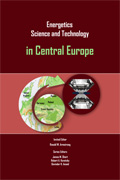Energetics Science and Technology
in Central Europe
Invited Editor
R. Armstrong
Series Editors
J. Short, R. Kavetsky, and D.K. Anand
ISBN 978-0-9846274-3-1
CALCE EPSC Press, University of Maryland, College Park, MD, 2011
|
'Energetics Science and Technology in Central Europe' is one book in a series of Center for Energetic Concepts Development books on Energetics Science and Technology in different parts of the world. This book is the 2nd in a planned series of six volumes. Each volume covers a different region of the world. Since European scientists were the first to improve on gunpowder and create an array of imaginative uses, for both civilian and military purposes, we selected Central Europe to be 2nd in the series. The editors designed the book to be a collection of chapters by energetic scientists living in and near Central Europe. We started by inviting scientists historically associated with NTREM - New Trends in Research of Energetic Materials.We invited chapters from the NTREM Chairman, Svatopluk Zemanof the Czech Republic; Scientific Committee Chairman, Adam Cumming of the United Kingdom; Scientific Committee |
|
|---|
members from Poland, Andrzej Maranda; Germany, Thomas Klapötke; Russia, David Lempert and Tatyana Pivina; and Turkey, Lemi Türker. We also invited Wanda Karas, Managing Editor of the Central European Journal of Energetic Materials, Poland; Manfred Bohn, Germany; Aleksandr Smirnov and Vladimir Klimenko, Russia. Joining Klimenko writing one of his two chapters are Ronald Armstrong and Davinder Anand of the United States.
Contact Ania Picard at picard@cecd.umd.edu to order a copy of this book.
Contents
Chapter 1 Teaching of the Chemistry and Technolofy of Explosives in the Czech Republic
1.1 History and Background
1.2 International Seminars NTREM
1.3 References
1.4Appendix - Lecture Program of the 14th Seminar NTREM (April 2011)
Chapter 2 Central European Research Activities and Collaboration
2.1 Introduction
2.2 Research Collaboration Areas and Mechanisms
2.3 References
Chapter 3 Central European Journal of Energetic Materials - The Newest in Europe
3.1 The Genesis of Central European Journal of Energetic Materials
3.2 Editorial Board
3.3 Statistics
3.4 Subject Area of CEJEM
3.5 References
Chapter 4 International Conferences on New Models
and Hydrocodes for Shock Wave Processes in Condensed Matter
4.1 The Early Conferences
4.2 Some Research Results
4.3 References
Chapter 5 The Synthesis Chemistry of Energetic Materials
5.1 High Explosives (HEDM)
5.2 Oxidizers (HEDO)
5.3 High Nitrogen Propellants
5.4 Pyrotechnics
5.5 References
Chapter 6 The Total Energy and Density of Certain Explosives: A Curious Relation
6.1 Introduction
6.2 Theory
6.3 Computational Methods
6.4 Results and Discussion
6.5 Conclusion
6.6 References
Chapter 7 Characterizations of Energetic Polynitrogen Compounds
7.1 History
7.2 Methodology
7.3 Calculational Tools for Prediction of EMs
Parameters
7.4 Analysis of the Possible Capacity for Energetic
Materials Parameters
7.5 Effectiveness of Compounds as Components for
Solid Composite Propellants
7.6 Results and Discussion
7.7 References
Chapter 8 Study of the Initiation Reactivity of Energetic Materials
8.1 Introduction
8.2 Approach to the Problem
8.3 Initiation by Heat
8.4 Impact Sensitivity (Reactivity)
8.5 Initiation by Shock
8.6 Friction Sensitivity (Friction Reactivity)
8.7 Electric Spark Sensitivity
8.8 Difference between Nitramine and Nitro Groupings in Molecules of EMs
8.9 Relationship between Data for Different Reactivities
8.10 Comparison of Splitting Polynitro Arenes by Heat and by Shock
8.11 Conclusions
8.12 References
Chapter 9 Review and Analysis of Data on the Dislocation Mechanism of High Explosive Decomposition
9.1 Introduction
9.2 Continuous Approach
9.3 Micro-level Approach
9.4 Amazing Results from the 1970s
9.5 Reactions under Pressure and Shear
9.6 Approach at the Molecular Level
9.7 Conclusions
9.8 References
Chapter 10 Impacts on the Loss Factor Curve and Quantification of Molecular Rearrangement Regions from it in Elastomer Bonded Energetic Formulations
10.1 The Loss Factor and Its Meaning
10.2 Interpretation and Prognostic of Molecular Mobility
10.3 Intermolecular Interactions as Key Property for
Glass Transition Temperature Ranges
10.4 Typical Glass Transition Temperatures of some
Binders Determined by DMA
10.5 Modeling of Loss Factor Curve to Quantify
Mobility Regions
10.6 Modeling of Loss Factor Curves Subjected to
Change of One Experimental Quantity
10.7 Summary and Conclusions
10.8 Abbreviations
10.9 Acknowledgements
10.10 References
Chapter 11 Industrial Explosives in Polish Mining
11.1 Introduction
11.2 Classification and Use of Mining Explosives
11.3 Profile of the Individual Groups of Mining
Explosives
11.4 Summary
11.5 References


